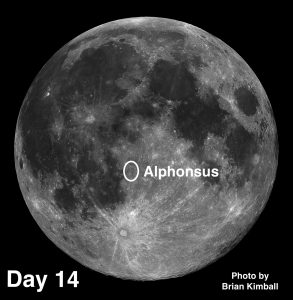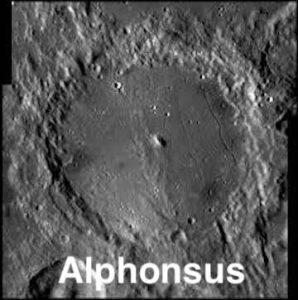 The week of May 28 – June 3 takes us from Day 14 (essentially full moon) through Day 19. This week we will highlight the craters Aristillus, Alphonsus, and Archimedes, visible on Monday – Wednesday.
The week of May 28 – June 3 takes us from Day 14 (essentially full moon) through Day 19. This week we will highlight the craters Aristillus, Alphonsus, and Archimedes, visible on Monday – Wednesday.
Aristillus: [NE/F10] We were first introduced to Aristillus in a previous blog for Day 7 when its more complex features (ramparts, central mountain peaks, terraces, etc.) were conspicuous because of the low sun angle. Under a full Moon, we can now see that Aristillus is also at the center of a ray system, which means that the crater is less than a billion years old – a mere youngster in lunar terms!
 Alphonsus: [SW/L9] We last observed Alphonsus on Day 7 where we learned about pyroclastic eruptions1. Although other features of the crater disappear under the full Moon, the dark halos resulting from pyroclastic eruptions should still be clearly visible on the floor of Alphonsus.
Alphonsus: [SW/L9] We last observed Alphonsus on Day 7 where we learned about pyroclastic eruptions1. Although other features of the crater disappear under the full Moon, the dark halos resulting from pyroclastic eruptions should still be clearly visible on the floor of Alphonsus.
Archimedes: [NW/G9] Around full Moon Archimedes will sometimes display, however faintly, a series of bands running across its floor from southwest to northeast. Look closely and you might be able to see that the bands continue unbroken up the N.E. crater rim and onto the Imbrium floor beyond.
1 Pyroclastic Eruptions: A substance that is composed chiefly of rock fragments of volcanic origin is called pyroclastic (from two Greek words meaning broken by fire). On the Moon it refers to a little-known but fascinating phenomenon called explosive pyroclastic eruptions. As magma and molten rocks spewed out from volcanic vents, sometimes gases that were trapped within suddenly expanded and caused the rocks to explode in a shower of tiny dark glass beads. The result was that the area surrounding the source vent was covered by a dark halo of pyroclastic deposits. There are several areas on the Moon where you can see these deposits through backyard telescopes, but the crater Alphonsus is the best example. The Aristarchus Plateau [Day 11; NW/G4-5] is entirely covered with pyroclastic ash 30 – 100 feet thick. The Plateau has attracted the attention of NASA as an area for lunar colonization because hydrogen and oxygen can be extracted from the ash, providing fuel, water, and breathable air.
======================
It is highly recommended that you get a copy of Sky and Telescope’s Field Map of the Moon, the very finest Moon map available for use at the telescope. It is available for $10.95 at www.skyandtelescope.com and on Amazon. All features mentioned in this blog will be keyed to the grid on the Field Map and will look like this: Plato: [NW/D9]
Credits:
Courtesy of Gray Photography of Corpus Christi, Texas
Lunar photos: NASA / USGS / BMDO / LROC / ASU / DLR / LOLA / Moon Globe. Used by permission
- Trio of Moon Craters with Distinct Personalities - April 22, 2024
- Hippalus Rilles on the Moon - April 15, 2024
- Moon Crater Janssen: How New Moon Craters are Superimposed on Top of Older Craters - April 8, 2024